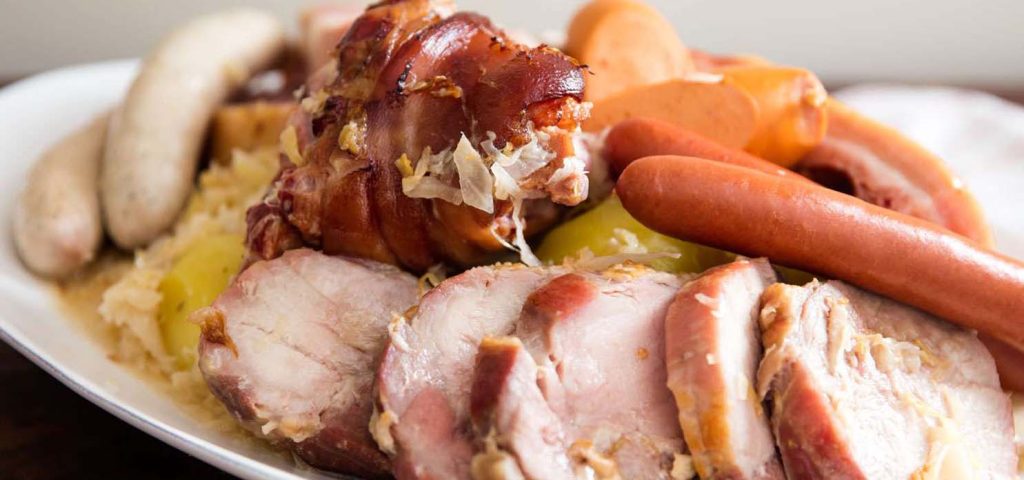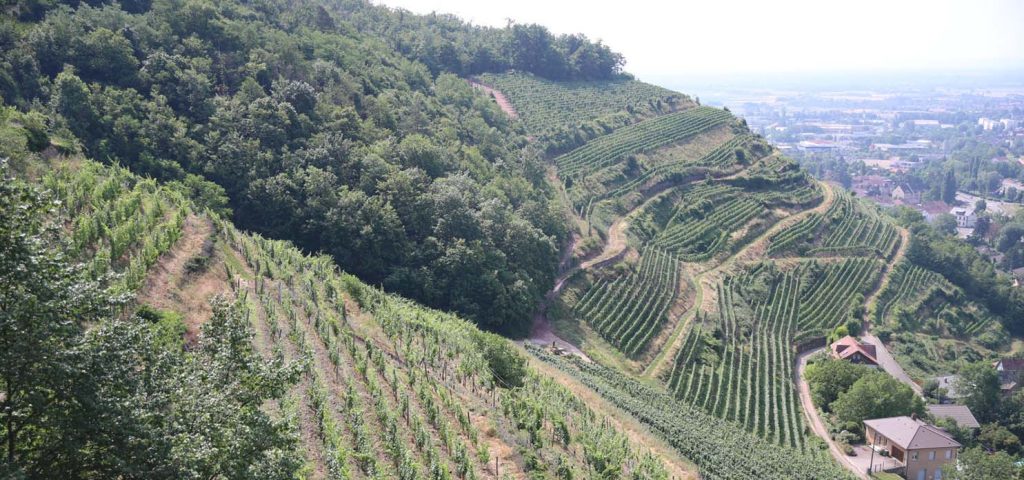Exploring the charming town of Mulhouse isn’t just about admiring its historical architecture and cultural treasures; it’s also an opportunity to embark on a culinary journey through the heart of Alsace. Join me as we delve into the delectable world of Alsatian cuisine, savoring the flavors that make Mulhouse a true gastronomic gem.
A Taste of Alsace
Alsace, a region nestled between France and Germany, is renowned for its distinctive cuisine that beautifully marries French finesse with hearty German flavors. As I ventured into Mulhouse’s culinary scene, I was eager to experience the rich tapestry of tastes that Alsace had to offer.
The Alsatian cuisine is a delightful fusion of tradition and innovation, and it’s best enjoyed at local restaurants that take pride in preserving the authenticity of their dishes. Here are some culinary highlights I couldn’t resist during my visit:
Flammekueche: A Crispy Delight
Our culinary journey begins with a beloved Alsatian classic, the Flammekueche. Sometimes referred to as “Tarte Flambée” in French, this dish is a masterpiece of simplicity and flavor. It consists of a thin, crispy dough base topped with crème fraîche, onions, and lardons (smoked bacon). The result is a harmonious blend of creamy, smoky, and slightly sweet flavors.
Where to Savor It: Head to Le Caveau (15 Rue des Boulangers) for an unforgettable Flammekueche experience. Their dedication to crafting this dish to perfection is evident in every bite. Prices start at around €10.
Choucroute Garnie: Hearty and Satisfying

Choucroute Garnie is the Alsatian take on sauerkraut, and it’s a dish that truly warms the soul. A generous serving of fermented cabbage is paired with an assortment of sausages, smoked meats, and often a succulent pork knuckle. This hearty and satisfying dish is the epitome of Alsatian comfort food.
Where to Savor It: Make your way to La Maison Alsacienne (12 Rue des Boulangers) for an authentic Choucroute Garnie. The cozy atmosphere and generous portions will leave you thoroughly satisfied. Prices typically range from €18 to €22.
Baeckeoffe: Slow-Cooked Elegance
Baeckeoffe is a testament to the Alsatian love for slow-cooked dishes. This casserole-style meal combines marinated cuts of lamb, beef, and pork with layers of sliced potatoes and aromatic vegetables. The entire ensemble is then gently simmered in white wine until the flavors meld into a symphony of taste.
Where to Savor It: Le Gruber (13 Rue de la Moselle) is the go-to place for a divine Baeckeoffe experience. Their attention to detail and the use of quality ingredients truly elevate this traditional dish. Prices start at approximately €20.
Munster Cheese
Cheese lovers, rejoice! Munster, a pungent cow’s milk cheese, is a cherished Alsatian delicacy. With its strong aroma and creamy interior, it’s not for the faint of heart. But if you’re a fan of bold flavors, Munster is a must-try. It’s often served with caraway seeds and a slice of dense Alsatian bread.
Where to Savor It: Sample Munster cheese at La Cloche à Fromage (18 Rue de la Moselle), a cozy cheese shop that offers a curated selection of Alsace’s finest cheeses. Prices vary depending on your cheese selection.
Kugelhopf: A Sweet Finish
No Alsatian meal is complete without a sweet indulgence. This ring-shaped cake is made with a rich, yeasty dough that’s studded with raisins and almonds. It’s baked to perfection, resulting in a golden, fragrant delight.
Where to Savor It: Pâtisserie Hanss (29 Rue de la Moselle) is a renowned pastry shop where you can savor the best Kugelhopf in town. Pair it with a strong Alsatian coffee for the ultimate dessert experience. Prices start at around €3 per slice.
Practical Tips for Dining in Mulhouse
Now that we’ve explored the culinary treasures of Alsace, here are some practical tips to enhance your dining experience in Mulhouse:
- Reservations: Many popular restaurants in Mulhouse, especially those in the Old Town, can get quite busy during peak hours. It’s advisable to make reservations in advance to secure your table.
- Cash and Cards: Credit and debit cards are widely accepted in most restaurants, but it’s a good idea to carry some cash, especially for smaller establishments and market purchases.
- Tipping: Tipping in France is customary, and it’s typically around 10% of the bill. However, it’s always a good practice to check if service charge is included in the bill.
- Local Etiquette: When dining in traditional Alsatian restaurants, you’ll often find communal tables. Don’t be surprised if you’re seated with other diners; it’s a part of the convivial Alsatian dining experience.
- Opening Hours: Restaurants in France often have set opening hours, with breaks between lunch and dinner service. Lunch is typically served from 12:00 PM to 2:00 PM, and dinner from 7:00 PM to 9:30 PM. Be sure to check the opening hours of your chosen restaurant.
Exploring Mulhouse’s Wine Scene
My journey through Mulhouse’s culinary delights led me to another captivating aspect of Alsace’s gastronomy—the exceptional wines. Alsace is renowned for its white wines, and Mulhouse offers the perfect opportunity to savor these liquid treasures. Join me as we explore the world of Alsatian wines and the charming vineyards that produce them.
Alsace’s Wine Heritage
Alsace’s wine-making tradition dates back centuries, with the region’s vineyards producing some of the world’s most distinguished white wines. The unique terroir, characterized by its mix of volcanic soils, limestone, and a favorable climate, contributes to the exceptional quality of Alsatian wines.
One of the key characteristics of Alsace wines is their purity and expressiveness. These wines predominantly showcase single grape varieties, allowing each one to shine and exhibit its distinct flavors and aromas. Alsace is particularly celebrated for its Riesling, Gewürztraminer, Pinot Gris, and Muscat wines.
Wine Tasting in Mulhouse
While Mulhouse itself isn’t a major wine-producing town, it serves as an excellent base to explore the surrounding Alsace wine regions. Here are a few ways to savor Alsatian wines while in Mulhouse:
Wine Bars:
When exploring the culinary and oenological delights of Mulhouse, one mustn’t overlook the city’s charming wine bars. These establishments are veritable havens for wine enthusiasts and offer an excellent opportunity to savor the rich tapestry of Alsatian wines.
1. Le Vintage Wine Bar
Hidden away in the heart of Mulhouse’s historic Old Town, Le Vintage Wine Bar exudes an air of sophistication from the moment you step through its doors. The dimly lit interior is adorned with vintage wine barrels, creating an intimate ambiance that’s perfect for a romantic evening or a relaxed gathering of friends.
The wine list at Le Vintage is a treasure trove of Alsatian wines, featuring selections from renowned vineyards and lesser-known gems waiting to be discovered. The bar’s knowledgeable staff, true aficionados of the local wine scene, are more than happy to assist in selecting the perfect glass or bottle to suit your palate.
As I settled into a cozy corner, I was presented with a flight of Alsatian white wines, each paired with delectable local cheeses and charcuterie. The Gewürztraminer’s floral notes and the Pinot Gris’s silky texture left a lasting impression. With every sip, I couldn’t help but appreciate the artistry of Alsatian winemaking.
2. Vinoclub Wine Lounge
Nestled along the tranquil Ill River, Vinoclub Wine Lounge offers a serene setting for wine enthusiasts to unwind. The lounge’s modern décor and floor-to-ceiling windows create a feeling of openness and connection to nature, making it an excellent spot for an afternoon or early evening rendezvous.
Vinoclub’s wine selection is an eclectic mix of Alsatian classics and international vintages. It’s the perfect place to explore wines from beyond Alsace while still indulging in local flavors.
3. La Cave du Vieux Couvent
For those seeking a more immersive wine experience, La Cave du Vieux Couvent is a must-visit. This wine cellar, housed in a former convent, is a haven for wine collectors and connoisseurs alike. Its vaulted stone ceilings and rustic charm provide a unique backdrop for wine tastings and gatherings.
The wine cellar offers an extensive selection of Alsatian wines, including rare and limited-edition bottles that are sure to intrigue even the most discerning palates. During my visit, I had the privilege of partaking in a vertical tasting of Rieslings from a prestigious Alsatian estate. It was a fascinating journey through the nuances of each vintage, and the sommelier’s insights added depth to the experience.
Vineyard Visits:
Take a short drive from Mulhouse to the heart of Alsace’s wine country. Visit vineyards and cellars for a more immersive wine experience. Many vineyards offer guided tours and tastings, allowing you to learn about the wine-making process.
Wine Festivals:
If your visit coincides with one of Alsace’s numerous wine festivals, don’t miss the opportunity to participate. These lively events showcase local wines, cuisine, and culture in a festive atmosphere.
Notable Wineries Near Mulhouse
While exploring the Mulhouse region, consider visiting some of the renowned wineries that call Alsace home. Here are two notable options:

Domaine Schlumberger: Located in Guebwiller, approximately 45 minutes from Mulhouse, Domaine Schlumberger is one of the oldest and most prestigious wineries in Alsace. Their vineyards, nestled on the slopes of the Vosges Mountains, produce exceptional Riesling, Gewürztraminer, and Pinot Gris wines. The winery offers guided tours and tastings amid breathtaking scenery.
Domaine Zind-Humbrecht: Situated in Turckheim, about an hour’s drive from Mulhouse, Domaine Zind-Humbrecht is another acclaimed Alsatian winery. Their commitment to biodynamic farming and their passion for terroir-driven wines have earned them international recognition. Visits to the estate provide a glimpse into their sustainable wine-making practices and an opportunity to sample their exceptional offerings.
Practical Tips for Wine Tasting
Here are some practical tips to enhance your wine-tasting experience in Mulhouse and Alsace:
- Designated Driver: If you plan to visit multiple vineyards in one day, consider having a designated driver or arranging for a wine tour with transportation.
- Tasting Etiquette: When participating in tastings, it’s customary to swirl, sniff, and savor the wine before expressing your impressions. You can expect to pay a small fee for tastings, which is often waived with the purchase of wine.
- Shipping Wine: If you find wines you adore but can’t carry them with you, inquire about shipping options. Many wineries offer shipping services to international destinations.
- Wine Events: Check for local wine events and festivals in Alsace. These gatherings provide an excellent opportunity to sample a wide range of wines in one location.
As I sipped my way through Alsace’s exquisite wines, I marveled at the region’s dedication to producing wines that not only reflect the terroir but also encapsulate the passion and heritage of the people. The wines of Alsace are more than beverages; they are an invitation to immerse oneself in a world of flavors and stories, each bottle holding a piece of the region’s rich history.
From savoring mouthwatering local dishes in charming bistros to indulging in the finest wines in elegant wine bars, Mulhouse has proven to be a destination that celebrates the art of gastronomy and oenology.
Mulhouse’s culinary landscape, deeply rooted in Alsatian traditions, offers a gastronomic voyage that’s both comforting and exciting. Whether you’re delving into the savory realm of choucroute garnie, sipping on aromatic Gewürztraminers, or relishing a slice of tarte flambée, each bite and sip is an invitation to discover the rich tapestry of flavors that define Alsace.May your travels be filled with delectable delights, cultural revelations, and the warm embrace of Alsace’s hospitality.
